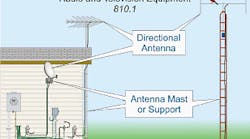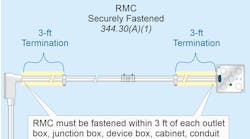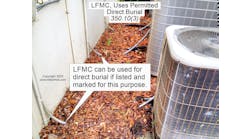All questions and answers are based on the 2011 NEC.
Q. What are the requirements for antenna grounding?
A. Article 810 contains the installation requirements for the wiring of television and radio receiving equipment, such as digital satellite receiving equipment for television signals and amateur/citizen band radio equipment antennas, as shown in the Figure.
The antenna mast [810.15] and antenna discharge unit [810.20(C)] must be grounded as follows [810.21]. Grounding the lead-in antenna cables and the mast helps prevent voltage surges caused by static discharge or nearby lightning strikes from reaching the center conductor of the lead-in coaxial cable. Because the satellite dish sits outdoors, wind creates a static charge on the antenna as well as on the cable attached to it. This charge can build up on both the antenna and the cable until it jumps across an air space, often passing through the electronics inside the low noise block down converter feedhorn (LNBF) or receiver. Connecting the coaxial cable and dish to the building grounding electrode system (grounding) helps to dissipate this static charge.
Nothing can prevent damage from a direct lightning strike, but grounding with proper surge protection can help reduce damage to the satellite dish and other equipment from nearby lightning strikes. Lightning doesn’t like to travel around corners or through loops, which is why the bonding conductor or grounding electrode conductor must be run as straight as practicable [810.21(E)].
The bonding conductor or grounding electrode conductor to the electrode [810.21(F)] must be copper or other corrosion-resistant conductive material. It can be stranded or solid, insulated, covered, or bare [810.21(A) and (B)]. The bonding conductor or grounding electrode conductor must be securely fastened in place and must be mechanically protected where subject to physical damage. Where installed in a metal raceway, both ends of the raceway must be bonded to the bonding conductor or grounding electrode conductor, although installing it in PVC conduit is a better practice [810.21(C) and (D)].
The bonding conductor for the antenna mast and antenna discharge unit must terminate to the intersystem bonding termination as required by 250.94, if there is one available. Bonding all communication systems to the intersystem bonding termination helps reduce induced potential (voltage) differences between the power and the radio and television systems during lightning events [100, 250.94 and 810.21(F)].
In a building or structure without an intersystem bonding termination, the bonding conductor or grounding electrode conductor for the antenna mast and antenna discharge unit must terminate to the nearest accessible location on the following [810.21(F)(2)]:
- Building/structure grounding electrode system [250.50].
- Interior metal water piping system, within 5 ft from its point of entrance [250.52(A)(1)].
- Accessible means external to the building, as covered in 250.94.
- Nonflexible metallic service raceway.
- Service equipment enclosure.
- Grounding electrode conductor or the grounding electrode conductor metal enclosure.
If a building or structure does not have any grounding means, then the grounding electrode conductor for the antenna mast and antenna discharge unit must be connected to any grounding electrode as described in 250.52.
The bonding conductor or grounding electrode conductor can be installed either inside or outside the building and must not be smaller than 10 AWG copper or 17 AWG copper-clad steel or bronze. Copper-clad steel or bronze wire is often molded into the jacket of the coaxial cable to simplify the
grounding of the lead-in conductor from an outdoor antenna to the discharge unit [810.21(F)]. If a ground rod is installed to serve as the grounding electrode for the radio and television equipment, it must be connected to the building’s power grounding electrode system with a minimum 6 AWG conductor. Termination of the bonding conductor or grounding electrode conductor must be by exothermic welding, listed lugs, listed pressure connectors, or listed clamps. Grounding fittings that are concrete-encased or buried in the earth must be listed for direct burial [250.70].
Q. I’m confused with the rules associated with taps. Can you please explain the 10-ft feeder tap rule and provide an example to better illustrate a proper installation?
A. Feeder tap conductors up to 10 ft long are permitted without overcurrent protection at the tap location if the tap conductors comply with the following [240.21(B)(1)]:
- The ampacity of the tap conductor must not be less than the calculated load in accordance with Art. 220 and the rating of the device or overcurrent device supplied by the tap conductors.
- The tap conductors must not extend beyond the equipment they supply.
- The tap conductors are installed in a raceway if they leave the enclosure.
- If the tap conductors leave the enclosure or vault in which the tap is made, the tap conductors must have an ampacity not less than 1/10th of the rating of the overcurrent device that protects the feeder.
Here’s an example of how it works in the field. Let’s say you have a 400A breaker that protects a set of 500kcmil feeder conductors. There are three taps fed from the 500kcmil feeders that supply disconnects with 200A, 150A, and 30A overcurrent devices. What are the minimum size conductors for these taps?
200A disconnect: 3/0 AWG is rated 200A at 75°C, and is greater than 10% of the rating of the 400A breaker (400A × 0.10 = 40A).
150A disconnect: 1/0 AWG is rated 150A at 75°C, and is greater than 10% of the rating of the 400A breaker (400A × 0.10 = 40A).
30A disconnect: 8 AWG is rated 50A at 75°C, and is greater than 10% of the rating of the 400A breaker (400A × 0.10 = 40A). Anything smaller than 8 AWG can’t be used, as it will have an ampacity of less than 10% of 400A (40A).





